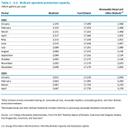Valero Energy Corp. released second quarter financial results on July 27, reporting improved operating income for both its renewable diesel and ethanol business segments. The company also said its SAF project is progressing on schedule.
U.S. fuel ethanol production was up 2 percent the week ending July 21, according to data released by the U.S. Energy Information Administration on July 26. Stocks of fuel ethanol were up slightly while exports were unchanged from the previous week.
UNICA, the Brazilian sugarcane industry association, has announced sugarcane process was up during the second half of June. Ethanol production was down for the two-week period, while ethanol sales were up for the full month.
U.S. fuel ethanol production expanded by nearly 4 percent the week ending July 14, according to data released by the U.S. Energy Information Administration on July 19. Stocks of fuel ethanol were up 2 percent while exports were up 69 percent.
The U.S. DOE's BETO on will host a Bioenergy Cybersecurity Workshop on Sept. 11. The virtual event will focus on the identification of cybersecurity risks in biofuel and bioproduct manufacturing as well as ways to address those risks.
Throughout the ethanol industry, multi-plant executive management is an approach that leads to unique opportunities for networking and growth for the plants involved. In recent years, multi-plant executive management has been on the rise. The boards of some ethanol plants are consolidating their resources by sharing a CEO between multiple plants—even those not owned by the same company—or hiring a CFO on a temporary basis. Ethanol Producer Magazine recently spoke with industry executives who manage two or more plants to shed light on why multi-plant executive management happens, as well as the benefits and challenges of this strategy.
U.S. fuel ethanol production fell by nearly 3 percent the week ending July 7, according to data released by the U.S. EIA on July 12. Weekly ending stocks of fuel ethanol were up 2 percent while exports were down 36 percent.
Total operable biofuels production capacity in the U.S. expanded in April, according to data released by the U.S. Energy Information Administration on June 30. Feedstock consumption was up when compared to the same month of last year.
U.S. fuel ethanol production for the week ending June 23 was unchanged from the previous week, according to data released by the U.S. EIA on June 28. Ethanol stocks were up 1 percent while exports were up nearly 20 percent.
U.S. ethanol production was up more than 3 percent the week ending June 16, reaching the highest level since December 2022, according to data released by the U.S. EIA on June 22. Ethanol stocks were also up 3 percent, with exports up 14 percent.
The USDA recently released its Grain Crushings and Co-Products Production report for June, reporting that corn use for fuel ethanol production in April was down when compared to both the previous month and the same month of last year.
UNICA, the Brazilian sugarcane industry association, has announced sugarcane processing by mills in the south-central region of Brazil was up in late May. Ethanol production and sales were also up during the two-week period.
The ethanol industry has a role to play in the emerging SAF indsutry through both ethanol-to-jet technologies and the supply of distillers corn oil feedstock.
The rise of renewable diesel production—and what’s coming with SAF—is elevating demand for distillers corn oil. New technologies could push DCO values even further.
IFF has established a next-gen ethanol modeling and services toolkit to go with its flexible portfolio of fermentation products.
A new technology developed by Proteum Energy could use ethanol as a feedstock for producing hydrogen, a very real contender in the hard-to-electrify sector.
ICM is leveraging whole stillage separation to improve DCO gains while bringing energy usage down through a more dry cake.
Summit Ag Investments’ ethanol plant, Amber Wave, is in the process of becoming the largest wheat protein producer in North America, while continuing to make low-carbon fuel. The food-versus-fuel debate has aggravated the ethanol industry for years, in spite of the fact that ethanol plant coproducts feed animals across the country and around the world. Some producers even consider feed to be their main product—ethanol being second—and one U.S. plant is now finding new purpose as a food ingredient producer while also creating ethanol from wheat starch.
In today’s volatile commodity market, ethanol producers are diversifying corn oil production to increase profits by upgrading their commodity DCO to a cleaner oil, TruDCO—a low-impurity, low-moisture, and low carbon corn oil.
More than 2.11 billion renewable identification numbers (RINs) were generated under the Renewable Fuel Standard in May, up from 1.84 billion generated during the same month of last year, according to data released by the U.S. EPA on June 15.
U.S. fuel ethanol production fell by nearly 2 percent the week ending June 9, according to data released by the U.S. EIA on June 14. Ethanol stocks were down more than 3 percent and exports were down 22 percent when compared to the previous week.
ArcelorMittal and LanzaTech Global Inc. on June 14 announced that ArcelorMittal’s commercial flagship CCU facility in Ghent, Belgium, has produced initial samples of ethanol. The "Steelanol" facility is expected to be fully operational this year.
The U.S. Energy Information Administration reduced its forecasts for 2023 and 2024 fuel ethanol production in its latest Short-Term Energy Outlook, released June 5. The forecasts for fuel ethanol blending were maintained.
A survey of U.S. ethanol producers shows the industry to be on track toward its net-zero-carbon goal, according to a new white paper and presentation released by the Renewable Fuels Association at the Fuel Ethanol Workshop & Expo.
Whitefox Technologies has announced that Redfield Energy LLC has decided to install a Whitefox ICE Plus membrane dehydration system at its ethanol plant in Redfield, South Dakota. The system is expected to be operational in Q3.
Fluid Quip Technologies has announced the successful start-up of their cutting-edge LED (low energy distillation) and GNS (grain neutral spirits) technologies at the Three Rivers Energy facility in Coshocton, Ohio.
U.S. fuel ethanol production expanded by 3 percent and reached a six-month high the week ending June 2, according to data released by the U.S. EIA on June 7. Ethanol stocks were also up by approximately 3 percent. Exports were up significantly.
The Renewable Fuels Association congratulates producer member Adkins Energy LLC as it celebrates its 20th anniversary this month. The celebration includes an open house at the Lena, Illinois, biorefinery on June 3.
U.S. operatable biofuels capacity expanded by 381 MMgy in March, with gains for renewable diesel, ethanol, and biodiesel. Total feedstock consumption was at 27.087 billion pounds in March, up from 24.537 billion pounds the previous month.
FS has announced its third corn ethanol plant in Brazil has begun operations. the 160 MMgy facility is located in the municipality of Primavera do Leste, Mato Grosso. In addition to ethanol, the facility produces corn oil, DDGs and electricity.
Advertisement




























